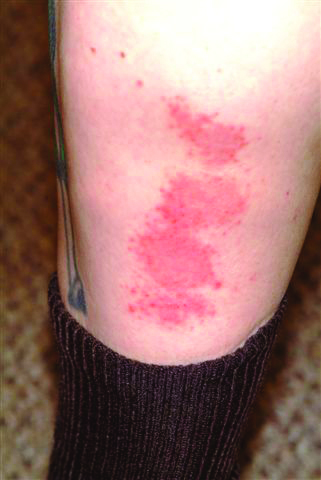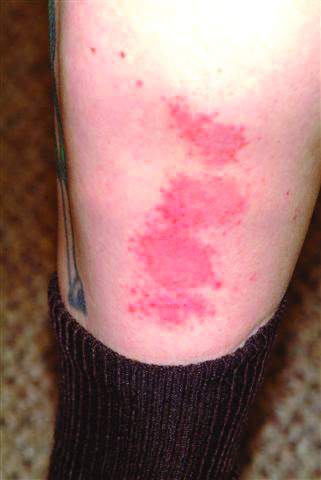User login
ANSWER
The correct answer is nummular eczema (choice “a”), an extremely common condition, especially in older men. Had this been psoriasis (choice “b”), the lesions would not have been so pruritic and would have displayed the characteristic thick, whitish scaling on a salmon pink base—and that diagnosis would, in all likelihood, have been corroborated by signs of psoriasis elsewhere on the patient’s body.
A fungal infection (choice “c”) can be difficult to treat but probably would have responded at least in part to one of the many medications the man tried. Other factors that spoke against this diagnosis were the negative KOH preparations and the apparent lack of specific sources (eg, pets or other animals) for such an infection.
Bowen’s disease (choice “d”) represents superficial epidermal squamous cell carcinoma—the round, scaly lesions of which are often mistaken for the other choices in this differential. But Bowen’s lesions will be fixed (permanent) instead of waxing and waning as this patient’s lesions did, will not itch to any appreciable extent, and will be found almost exclusively on chronically sun-damaged skin (which was not evident in this patient).
DISCUSSION
Nummular eczema (NE) is an extremely common condition with unclear origins. We often see it in the context of older patients with dry skin made drier by bathing habits, swimming, or use of hot tubs. But many cases appear without these conditions, causing much conjecture about potential triggers, such as contact versus irritant dermatitis. Indeed, the multiplicity of topical medications applied by this patient was probably making things worse, as is often the case.
NE typically manifests acutely, but can persist for months, worrying some patients a great deal. If need be, a 4-mm punch biopsy will rule out the other suspects in the differential diagnosis. Then the lesions can be treated, as in this case, with a class 1 or 2 topical steroid ointment or emollient cream, as well as advice about the need to limit the length of time spent in, and the temperature of, showers or hot tubs.
As with so many dermatologic conditions, patients with NE are greatly reassured just knowing about all the conditions they don’t have. And as is often the case for providers, just knowing a given condition such as NE exists and is common is a priceless asset.
ANSWER
The correct answer is nummular eczema (choice “a”), an extremely common condition, especially in older men. Had this been psoriasis (choice “b”), the lesions would not have been so pruritic and would have displayed the characteristic thick, whitish scaling on a salmon pink base—and that diagnosis would, in all likelihood, have been corroborated by signs of psoriasis elsewhere on the patient’s body.
A fungal infection (choice “c”) can be difficult to treat but probably would have responded at least in part to one of the many medications the man tried. Other factors that spoke against this diagnosis were the negative KOH preparations and the apparent lack of specific sources (eg, pets or other animals) for such an infection.
Bowen’s disease (choice “d”) represents superficial epidermal squamous cell carcinoma—the round, scaly lesions of which are often mistaken for the other choices in this differential. But Bowen’s lesions will be fixed (permanent) instead of waxing and waning as this patient’s lesions did, will not itch to any appreciable extent, and will be found almost exclusively on chronically sun-damaged skin (which was not evident in this patient).
DISCUSSION
Nummular eczema (NE) is an extremely common condition with unclear origins. We often see it in the context of older patients with dry skin made drier by bathing habits, swimming, or use of hot tubs. But many cases appear without these conditions, causing much conjecture about potential triggers, such as contact versus irritant dermatitis. Indeed, the multiplicity of topical medications applied by this patient was probably making things worse, as is often the case.
NE typically manifests acutely, but can persist for months, worrying some patients a great deal. If need be, a 4-mm punch biopsy will rule out the other suspects in the differential diagnosis. Then the lesions can be treated, as in this case, with a class 1 or 2 topical steroid ointment or emollient cream, as well as advice about the need to limit the length of time spent in, and the temperature of, showers or hot tubs.
As with so many dermatologic conditions, patients with NE are greatly reassured just knowing about all the conditions they don’t have. And as is often the case for providers, just knowing a given condition such as NE exists and is common is a priceless asset.
ANSWER
The correct answer is nummular eczema (choice “a”), an extremely common condition, especially in older men. Had this been psoriasis (choice “b”), the lesions would not have been so pruritic and would have displayed the characteristic thick, whitish scaling on a salmon pink base—and that diagnosis would, in all likelihood, have been corroborated by signs of psoriasis elsewhere on the patient’s body.
A fungal infection (choice “c”) can be difficult to treat but probably would have responded at least in part to one of the many medications the man tried. Other factors that spoke against this diagnosis were the negative KOH preparations and the apparent lack of specific sources (eg, pets or other animals) for such an infection.
Bowen’s disease (choice “d”) represents superficial epidermal squamous cell carcinoma—the round, scaly lesions of which are often mistaken for the other choices in this differential. But Bowen’s lesions will be fixed (permanent) instead of waxing and waning as this patient’s lesions did, will not itch to any appreciable extent, and will be found almost exclusively on chronically sun-damaged skin (which was not evident in this patient).
DISCUSSION
Nummular eczema (NE) is an extremely common condition with unclear origins. We often see it in the context of older patients with dry skin made drier by bathing habits, swimming, or use of hot tubs. But many cases appear without these conditions, causing much conjecture about potential triggers, such as contact versus irritant dermatitis. Indeed, the multiplicity of topical medications applied by this patient was probably making things worse, as is often the case.
NE typically manifests acutely, but can persist for months, worrying some patients a great deal. If need be, a 4-mm punch biopsy will rule out the other suspects in the differential diagnosis. Then the lesions can be treated, as in this case, with a class 1 or 2 topical steroid ointment or emollient cream, as well as advice about the need to limit the length of time spent in, and the temperature of, showers or hot tubs.
As with so many dermatologic conditions, patients with NE are greatly reassured just knowing about all the conditions they don’t have. And as is often the case for providers, just knowing a given condition such as NE exists and is common is a priceless asset.

A 70-year-old man self-refers to dermatology for evaluation of very itchy lesions that have been present for at least three months. The patient reports that the lesions have persisted despite the use of “everything but the kitchen sink”—meaning several OTC topical preparations, including those containing benzocaine, neomycin/polymyxin/bacitracin, and diphenhydramine, as well as “every antifungal cream I could buy.” The man has also tried pouring alcohol and peroxide over the lesions, again to no good effect. The lesions appeared in the midst of a long, cold winter with very low humidity; they itch terribly, causing the patient to scratch them vigorously. The lesions, which come and go, concern him not only because of the pruritus, but because his family is convinced he has some sort of “worms.” Further history taking reveals that the patient is not taking any new medications in addition to his simvastatin and metoprolol. He is not atopic and has no new pets, but he does admit to being “addicted” to sitting in his new hot tub. There is no history of gastric ulcers or dyspepsia, no joint pain, and no family history of psoriasis. Examination of the patient’s legs, particularly his calves, shows discrete and confluent round, scaly plaques of a striking reddish orange hue. They range from 1 to 5 cm in diameter. KOH prep of samples taken from two different lesions is negative for fungal elements. Elsewhere, the knees, elbows, nails, and scalp are free of any significant skin changes. There are no signs of chronic sun damage.
